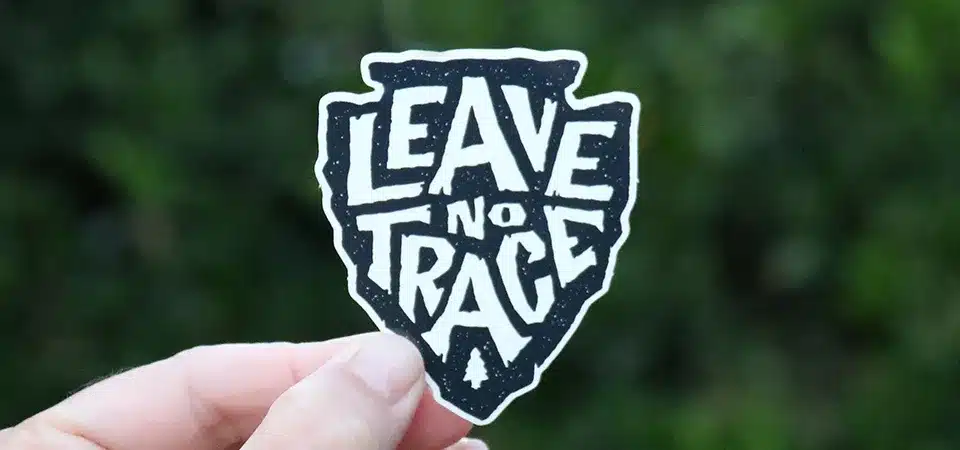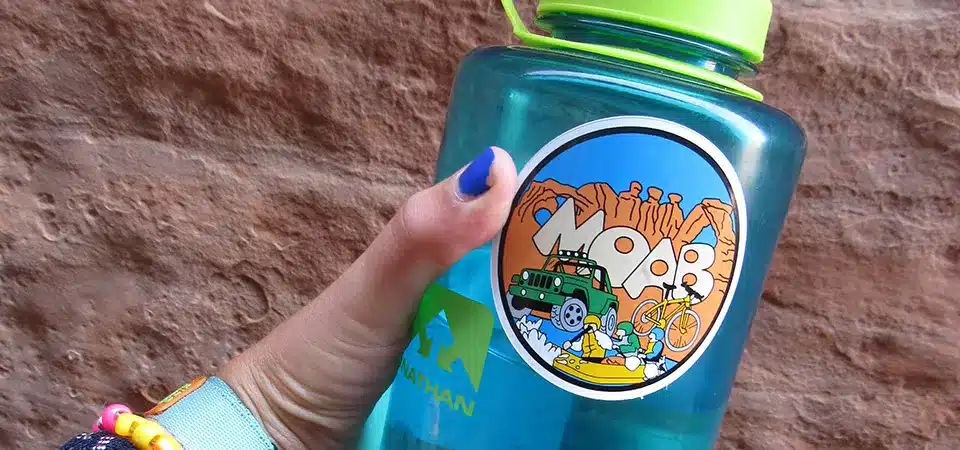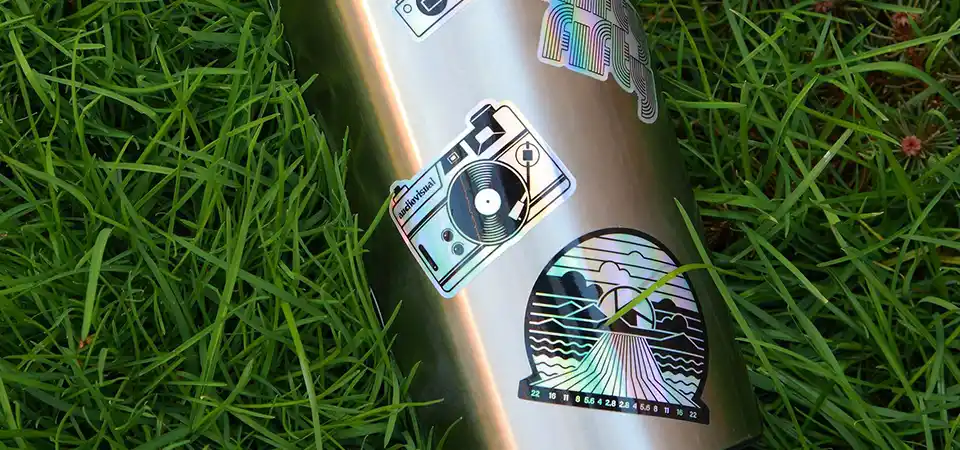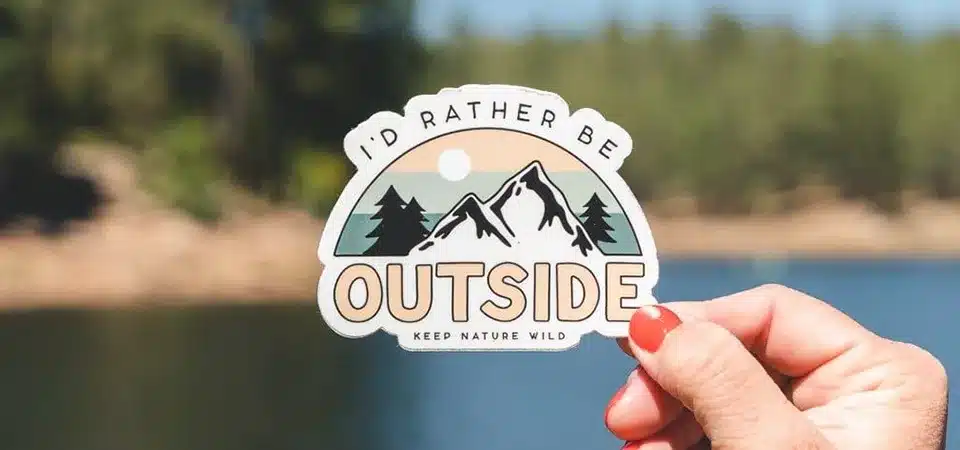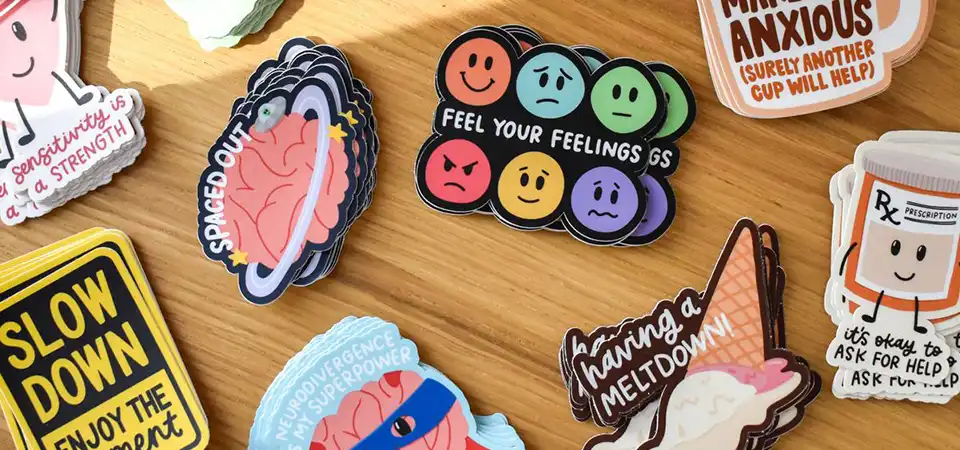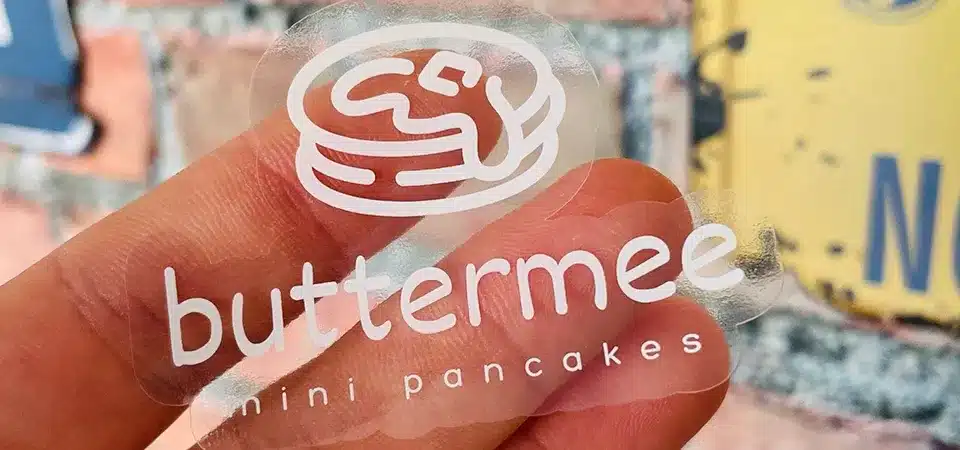Your brand new sticker looked amazing on your water bottle, but after one wash, it’s a peeling, smeared mess. It’s frustrating to waste money on stickers that don't last.
A truly waterproof sticker is made of a vinyl or PET base, printed with UV-resistant ink, and sealed with a laminate. The easiest home test is to submerge it in water for 24 hours. If the ink doesn't smear and the edges don't lift, it's waterproof.
As a sticker printing expert, I can tell you this: “waterproof” doesn’t always mean what you think. I see companies sell glossy paper stickers and call them waterproof, but they will never survive a real-world test. A truly durable sticker is a system of three parts: a plastic base, durable ink, and a protective top layer. Without all three, it will fail. Understanding the difference is key to buying stickers that look great and actually last. Let's break down exactly what to look for.
What’s the Difference Between Waterproof, Water-Resistant, and Weatherproof Stickers?
You see these terms used all the time, but they aren’t interchangeable. Ordering the wrong type is an easy mistake that means your sticker will fail you right when you need it most.
Waterproof means it can be fully submerged in water. Water-resistant can only handle light splashes. Weatherproof means it resists water, UV sunlight, and temperature changes, making it the best choice for a durable outdoor sticker.
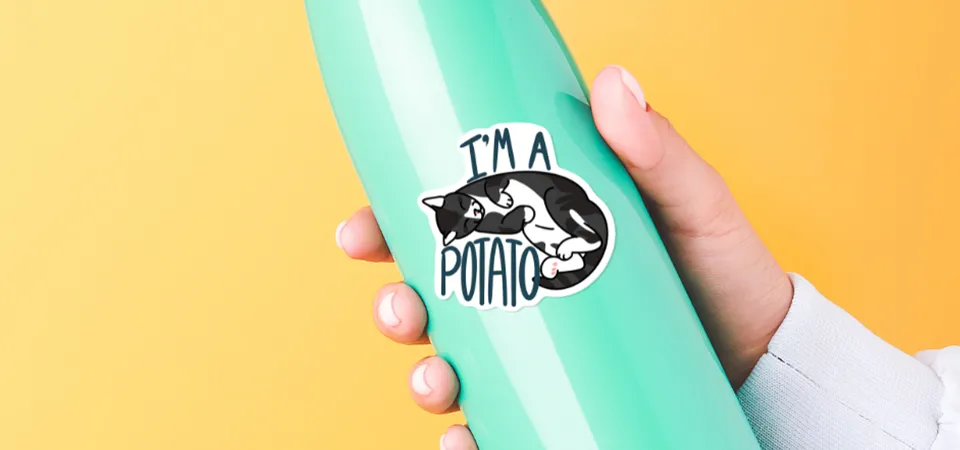
When I talk to new clients, this is one of the first things we clarify. Choosing the right level of protection saves them money and frustration. Think of it like a jacket: a water-resistant windbreaker is fine for a light drizzle, but you need a waterproof rain slicker for a downpour, and a weatherproof parka for a blizzard. Stickers work the same way.
Deconstructing The Terms
Each term describes a different level of durability. A sticker is only as strong as its weakest component—the base material, the ink, or the adhesive.
-
Water-Resistant: This is the lowest level of protection. These are typically paper-based stickers with a thin, glossy coating. They can survive a quick splash or being wiped with a damp cloth, but if they get saturated, the paper will absorb water, the ink may run, and the edges will start to peel. They are not built for long-term exposure to moisture.
-
Waterproof: This means the sticker can be completely submerged in water without falling apart. The key here is the base material. Waterproof stickers are made from plastics like vinyl or polyester (PET), which don't absorb water. The adhesive and ink must also be strong enough to withstand being soaked. These are perfect for water bottles, lunch boxes, and anything that gets washed regularly.
-
Weatherproof: This is the highest level of protection. A weatherproof sticker is completely waterproof and has extra protection against the other elements. It includes a UV-blocking laminate to prevent the sun from fading the colors and a robust adhesive that can handle extreme heat and cold. This is the only type of sticker you should use on cars, outdoor gear, or signs.
| Feature | Water-Resistant | Waterproof | Weatherproof |
|---|---|---|---|
| Material | Coated Paper | Vinyl, PET, BOPP | Heavy-duty Vinyl |
| Durability | Handles light splashes | Can be fully submerged | Submersible, UV-resistant, temperature-proof |
| Outdoor Use | No | No (will fade) | Yes (3-5 years) |
| Common Use | Disposable packaging | Water bottles, laptops | Cars, helmets, outdoor gear |
How to tell if a sticker is dishwasher safe?
You put your favorite sticker-covered thermos in the dishwasher, and it came out a shredded, gooey mess. Now your bottle is ruined and your cool sticker is gone.
A sticker is only dishwasher safe if it is fully weatherproof. It must have a vinyl base, a strong permanent adhesive, and a durable laminate to survive the combination of high heat, harsh detergents, and high-pressure water jets.
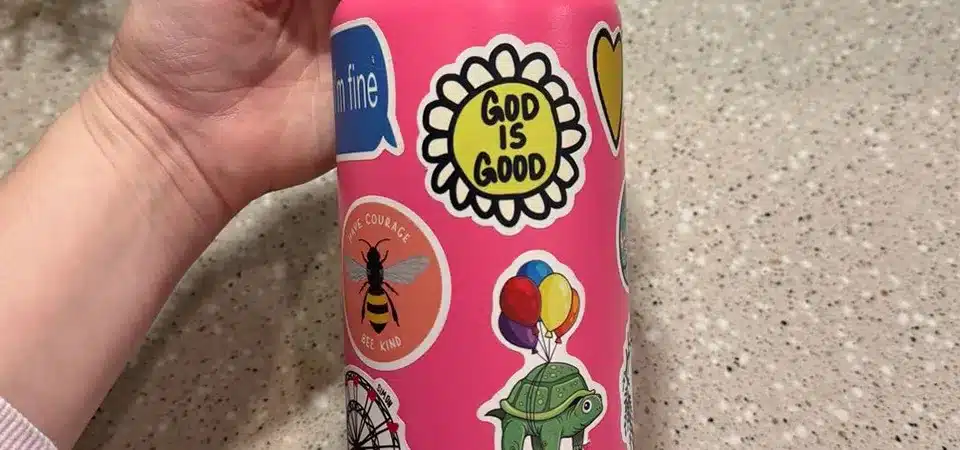
Dishwashers are sticker torture chambers. A sticker that is simply "waterproof" will not survive. I had a client who owned a coffee shop and wanted stickers for their ceramic mugs. We did a test run with some standard waterproof vinyl stickers. They survived a few hand washes just fine, but the first time they went through the commercial dishwasher, the heat and soap caused the edges to curl and the colors to look hazy. We had to upgrade them to a weatherproof sticker with a heavy-duty laminate. The dishwasher presents a three-pronged attack that requires a truly industrial-grade sticker to survive.
The Dishwasher Gauntlet
To be dishwasher safe, a sticker must withstand:
- High Heat: The drying cycle can reach temperatures that melt standard adhesives, causing the sticker to lose its grip and peel away.
- Harsh Detergents: The chemical agents in dishwasher soap are designed to break down oils and grime. Over time, these same agents can degrade the ink and adhesive on a sticker, causing it to fade or fall off.
- High-Pressure Water Jets: The powerful spray can get underneath any tiny lift in the sticker's edge, working it loose over time.
A truly dishwasher-safe sticker uses a heavy-duty laminate as a shield, a temperature-resistant adhesive that won't soften, and a vinyl base that won’t shrink or warp in the heat.
What kind of stickers are waterproof?
You're browsing online, but you're not sure what material to look for. You're at risk of buying a pack of stickers that are just glossy paper and won't last a week.
The most common waterproof stickers are made from vinyl. Other waterproof plastic materials include polyester (PET) and polypropylene (BOPP). Paper stickers, even with a glossy finish, are never truly waterproof because the base material will always absorb water.
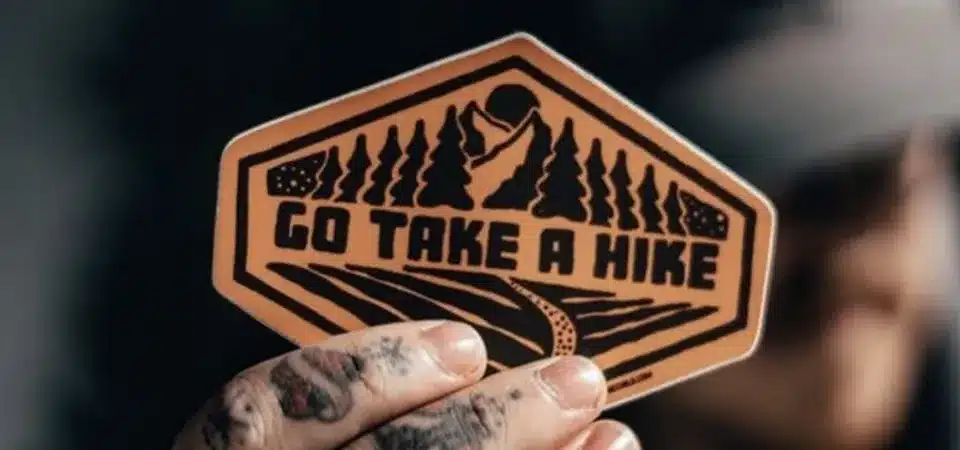
The secret to a waterproof sticker is that it isn't made of paper at all. It's made of plastic. In my printing business, we work with a few different types of plastic films, but the principle is the same for all of them: they don't absorb water. Think of it like the difference between a paper towel and a plastic bag. One is designed to soak up liquid, and the other is designed to contain it. The material of your sticker's base determines if it can ever be truly waterproof.
The Core Materials:
- Vinyl (PVC): This is the king of sticker materials and the industry standard for high-quality, durable stickers. It's a type of plastic that is flexible, strong, and completely waterproof. It's the material we use for everything from bumper stickers to professional product labels. It’s a bit more expensive than paper, but the durability is worth it.
- Polyester (PET): You might know this as the material used for water bottles. It's a very durable plastic film that is often used for clear stickers or labels that need to withstand high heat. It’s less flexible than vinyl but extremely tough.
- BOPP (Biaxially-Oriented Polypropylene): This is another type of plastic film, commonly used for product labels on things like cosmetics or food jars because it’s resistant to oils and chemicals.
And then there is paper. No matter how shiny the coating on top is, water will always find a way to the raw edge of the sticker. Once the paper edge gets wet, it acts like a wick, drawing moisture into the sticker from the side, causing it to swell, lose adhesion, and peel.
How Can You Test If a Sticker Is Truly Waterproof at Home?
A sticker is labeled "waterproof," but you're skeptical. You don't want to stick it on your new laptop or car until you know for sure that it will last.
Stick it to a clean glass or bottle and submerge it completely in water for 24 hours. After a full day, pull it out and rub the ink with your thumb. If the ink doesn't smear and the edges don't peel, it's genuinely waterproof.
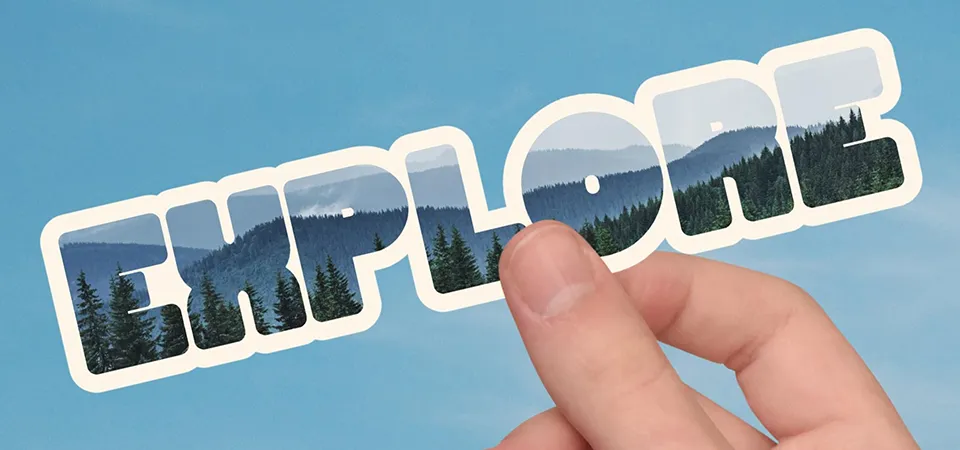
This is my go-to test whenever I'm evaluating a new material from a supplier. It's simple, cheap, and brutally effective. It perfectly mimics the harsh conditions a sticker will face over its life, but it accelerates the process. A poorly made sticker will fail this test in less than an hour. A high-quality vinyl sticker will look exactly the same after 24 hours as it did when you first put it on.
The 24-Hour Soak Test: A Step-by-Step Guide
- Prep the Surface: Take a clean, smooth object like a glass jar. Wipe the surface with rubbing alcohol to remove any oils from your fingers. This is a crucial step for good adhesion.
- Apply the Sticker: Press the sticker down firmly, starting from the center and smoothing outwards to push out any air bubbles. Let it sit for at least an hour to allow the adhesive to form a strong bond.
- Submerge It: Place the jar in a bowl of water, making sure the sticker is completely underwater.
- Wait 24 Hours: This is the hard part. Let it soak for a full day. This gives water plenty of time to penetrate any weaknesses.
- The Moment of Truth: Pull the jar out of the water. First, rub the printed area firmly with your thumb. If the ink is cheap or unlaminated, it will smear or rub off. Next, try to pick at the edge with your fingernail. If the sticker is truly waterproof, the edge will remain sealed and won't lift.
If it passes this test, you can be confident it will survive on your water bottle or laptop.
Does Lamination Make a Sticker Waterproof?
You've seen "laminated" stickers and assume that means they are waterproof. But this can be a misleading term that gives you a false sense of security.
Lamination is a critical part of a waterproof sticker, but it doesn't make the sticker waterproof on its own. It seals and protects the ink, but if the base material is paper, the sticker will still fail when water seeps in from the edges.
I like to explain this with an analogy. Think of your sticker's base material as the foundation of a house and the lamination as the roof. You can put the best, most expensive waterproof roof in the world on your house, but if the foundation is made of cardboard, the whole structure will still turn to mush in a rainstorm. The same is true for stickers. Lamination is a thin, clear plastic film that we apply over the top of the printed sticker. It's a non-negotiable part of a durable sticker system, but it's only one part.
Its main jobs are to:
- Seal the Printed Ink: The laminate provides a waterproof barrier over the ink, which is often the most vulnerable layer. This is what stops the ink from smearing or running.
- Protect from Scratches: It adds a tough layer that resists scuffs and scratches, keeping your sticker looking new.
- Block UV Rays: If you choose a UV laminate, it protects the ink's pigments from the sun, which is what prevents fading.
So, while lamination is essential, it's only effective when it's combined with a waterproof base material like vinyl. A laminated paper sticker is simply a slightly more water-resistant paper sticker.
How Long Do Waterproof Stickers Last Outdoors?
You want to put a sticker on your car bumper or snowboard, but you're worried it will look faded and cracked after just one season. What's a reasonable lifespan to expect?
A high-quality, weatherproof vinyl sticker with a UV-protective laminate will typically last 3 to 5 years outdoors. Cheaper stickers without lamination can start to badly fade, crack, or peel in as little as 6 months.

The lifespan of an outdoor sticker depends entirely on its ability to fight three enemies: sunlight, moisture, and temperature. In my experience, the sun is the most powerful enemy. Its UV radiation is relentless and will break down the color pigments in almost any ink over time. That's why the laminate is so important.
Here's what determines a sticker's outdoor life:
- UV Protection: The single most important factor. A sticker without a UV-blocking laminate will lose its color vibrancy very quickly. You'll see bright reds turn to pale pink and dark blacks turn to gray.
- Material Quality: A thick, durable vinyl is more resistant to becoming brittle and cracking from temperature changes than a thin, cheap vinyl.
- Adhesive Strength: The adhesive needs to be strong enough to stay put through rain, snow, and car washes without letting moisture creep under the edges.
I have stickers on my own car that I printed in my shop over 4 years ago. They look almost as good as new because I used our premium weatherproof vinyl with a heavy-duty UV laminate. The investment in quality materials upfront pays off with years of durability.
How to Spot Fake “Waterproof” Stickers Before You Buy?
You found an amazing deal on a huge pack of "waterproof" stickers online. But after you buy them, you discover they're just flimsy, glossy paper—a total waste of money.
Check the product description for the material type. If it says "paper" or is vague, be cautious. Look for keywords like "vinyl," "laminated," or "UV protected." If the price seems too good to be true, it almost certainly is.
Unfortunately, many online sellers mislead customers by labeling cheap paper stickers as waterproof. As a professional, it drives me crazy. But there are a few red flags you can look for to protect yourself before you click "buy."
Your Pre-Purchase Checklist:
- Read the Material Description: This is the most important clue. The seller should explicitly state that the stickers are made from "vinyl," "PET," or "BOPP." If the description says "high-quality paper," "glossy finish," or doesn't mention the material at all, assume they are not waterproof.
- Look for "Laminated": Reputable sellers of durable stickers will almost always mention that their product is laminated. Lamination is a key selling feature that adds cost, so they will want to advertise it. Look for terms like "UV laminate," "weatherproof coating," or "scratch-resistant."
- Analyze the Price: Quality materials cost more. Vinyl is significantly more expensive than paper. If you see a pack of 100 die-cut stickers for $5, it is physically impossible for them to be high-quality vinyl. That price point only works for paper.
- The Tear Test: If you already have the sticker, try to tear it. A paper sticker will rip easily. A vinyl sticker will not tear; it will stretch. It feels like a thin piece of plastic because that's what it is. This is a dead giveaway.
When in doubt, just ask the seller directly: "Are these stickers made from vinyl or paper?" A reputable seller will give you a clear, honest answer.
Conclusion
To tell if a sticker is waterproof, check for a plastic base like vinyl and a protective laminate. When in doubt, the 24-hour water submersion test is definitive proof.

